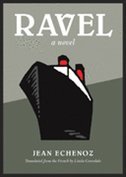Lightning is the third (and apparently final) instalment in French author Jean Echenoz’s trilogy of short, tightly-written fictional biographies. The exceptional Ravel, a look at the last 10 years of the composer’s life, kicked off the project a few years ago. That was followed by Running which featured the legendary Czech distance runner, Emil Zatopeck.
While Echenoz used real names in those two, Lightning‘s central charactor is a precocious engineer, Gregor — but the flyleaf informs us that he is “inspired by the life of Nikolai Tesla, often called ‘the man who invented the twentieth century.'”
Before getting to the book under review, however, let’s contemplate some common aspects of the “trilogy”. A composer, an athlete and a scientist — three fields of endeavor with virtually no overlap. Yet each of the three didn’t just push the envelope or break the mold in their chosen area, they added a whole new dimension. Ravel’s Bolero remains unique to this day. Zatopek’s “style” of running was so awkward and removed from the conventional norm that the experts marvelled that he could actually complete a race, let alone set world-record times. And Tesla lived so far in the scientific future, visualizing inventions ranging from radar to cellular technology decades before their “discovery”, that no one understood what he was really about.
In all three books (Lightning is the longest at 142 pages), the author succinctly documents those achievements. But from the start, he is also careful to portray another common side of his exceptional characters. They all shared aspects of social ineptness, despite wanting to fit into the world around them. And they all had what might best be generously described as “attention flaws” which made many aspects of daily living a challenge.
What is best about the three books, however, is Echenoz’s interest in another aspect shared by the three: all brilliant careers, whatever the field, must eventually ebb and come to an end. And all humans, however exceptional, die just like the guy next door. It is that decline which seems to interest the author the most, with the final third of each book devoted to the theme — and what makes each of these three characters so fully-formed. Here’s his introduction to that part of this book; it follows a list of the aging Gregor’s later ideas (an elastic-fluid turbine, a locomotive headlight, a hydraulic turbo-alternator):
Well, these ventures, like so many others, will never come to anything. And not only because of the indifference of his contemporaries, as Gregor mournfully maintains. Because in a man’s life, it sometimes happens as well that nothing works anymore, that the inventory of fixtures falls into disrepair. Here and there, bit by little bit, one sees how the mind deteriorates: just like matter does. It happens via addition and subtraction: sly elements join in — dirt, dust, mold — while precious ones degenerate through wear, fatigue, erosion. And then there’s the corrosion that attacks, chews up, and devours nerve cells the way it does atoms, producing all sorts of slowdown, cracking joints, aches, negligence, and hit-and-miss messiness. It’s a long, tortuous process, imperceptible at first, but which can sometimes, abruptly, become as plain as day.
I don’t think that I have ever read a better summary of a brilliant individual’s inevitable decline — and, yes, there are similar ones for both Ravel and Zatopek as they hit the closing period of their creative lives.
Back to the beginning. Gregor arrives in New York from Eastern Europe in the late nineteenth century, already bursting with ideas: a tube at the bottom of the Atlantic to carry mail between Europe and America, a gigantic ring immobilized above the equator “so that we could go inside it and circle the earth at about one thousand miles an hour…going “around the world” in a day.”
Obviously, these are not small-minded undertakings, for Gregor is bent upon confronting challenges of vast dimensions. Early on, along these lines, he becomes convinced he’d like to do a little something with tidal power, tectonic movements, or solar energy, phenomena like that, or — why not? — just to get his hand in, the falls at Niagara. He’s seen engravings of them in books and they’ll fit the bill. Yes, Niagara Falls. The Niagara River would be good.
Thomas Edison has already developed a system for delivering electricity but, alas, it is based on direct current and transmission losses are so great that users literally have to live within sight of the power plant. Gregor/Tesla introduces alternating current, an advance which immediately sweeps the market — his royalties should make him the richest person in the world, but he agrees to amend his contract with George Westinghouse and accepts a one-time payment of $198,000 for his invention. (There’s that daily life problem, showing up already.)
Still that success puts him in contact with America’s richest capitalists who are eager to back new ventures. He has some successes, even more good ideas that don’t get developed, but still has the legendary J.P. Morgan’s backing to construct a massive electrical tower on Long Island which not only means the development of radio transmission as a by-product, but also (only Gregor knows this) would supply the world with free electrical power. Alas, Marconi beats him to the post with a radio transmission across the Atlantic and Gregor has to come clean to Morgan about the larger aim of his project:
But, well, the great John Pierpoint Morgan might be touched by the vastness of the enterprise, you never know.
But really, of course you know: Morgan won’t be the least bit touched. Having never embraced the profession of philanthropist, the financier shows no enthusiasm at the idea of delivering current as free as the air to countries peopled by penniless Moldavians, Ainus, or Sengalese. Assuring Gregor that he continues to enjoy his deep personal sympathy and moral support, Morgan cuts off all credit with a stroke of the pen. Work on the tower comes to a halt at the snap of his fingers. Screwed again.
Please understand me, Morgan points out. It doesn’t work at all, your system. If everyone can draw on the power all they like, what happens to me? Where do I put the meter?
While I am giving it short shrift in this review, the author does every bit as good a job at portraying Gregor’s social ineptness. He is famous and successful enough with Westinghouse that he acquires champagne tastes — bespoke suits, hand-made shirts and a massive collection of shoes and ties. He lives, on credit, in a suite high in the Waldorf Astoria (his notion is that they should be honored enough by his residence not to tender a bill and, for a long time, they don’t).
The mental decline may be inevitable, but it is those human failings that hasten the lifestyle decline. Gregor still has a wealth of big ideas but increasingly no one is willing to listen. His ego was always bigger than even his grand ideas, so the scientific community has never welcomed him. The financiers abandon him in frustration. Society no long wants to be his patron. Everything that is contemplated in that paragraph that I quoted above starts to come to pass.
My knowledge of the history of science is sketchy enough that I can’t even hazard an opinion on how much Echenoz has exaggerated Tesla’s ideas and accomplishments — for this reader, Gregor came so fully to life that it doesn’t matter. My experience with the first two biographies had me aware early on, without the author’s forebodings, about what would be happening in the latter third of the novel. I wasn’t disappointed at all.
This is the sixth Echenoz novel reviewed on this blog (see all the reviews here) so he is obviously a KfC favorite. If you haven’t tried him, you should. And if Echenoz should happen to decide not to halt his fictional biographies with this one, I will be first in line to buy number four.




 Translated by Mark Polizzotti
Translated by Mark Polizzotti
 Translated from the French by Linda Coverdale
Translated from the French by Linda Coverdale